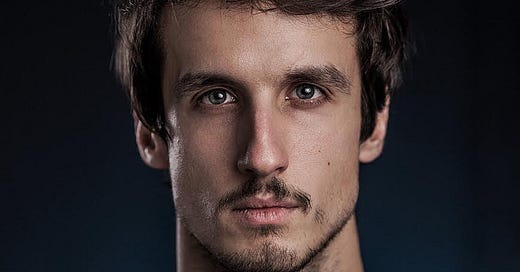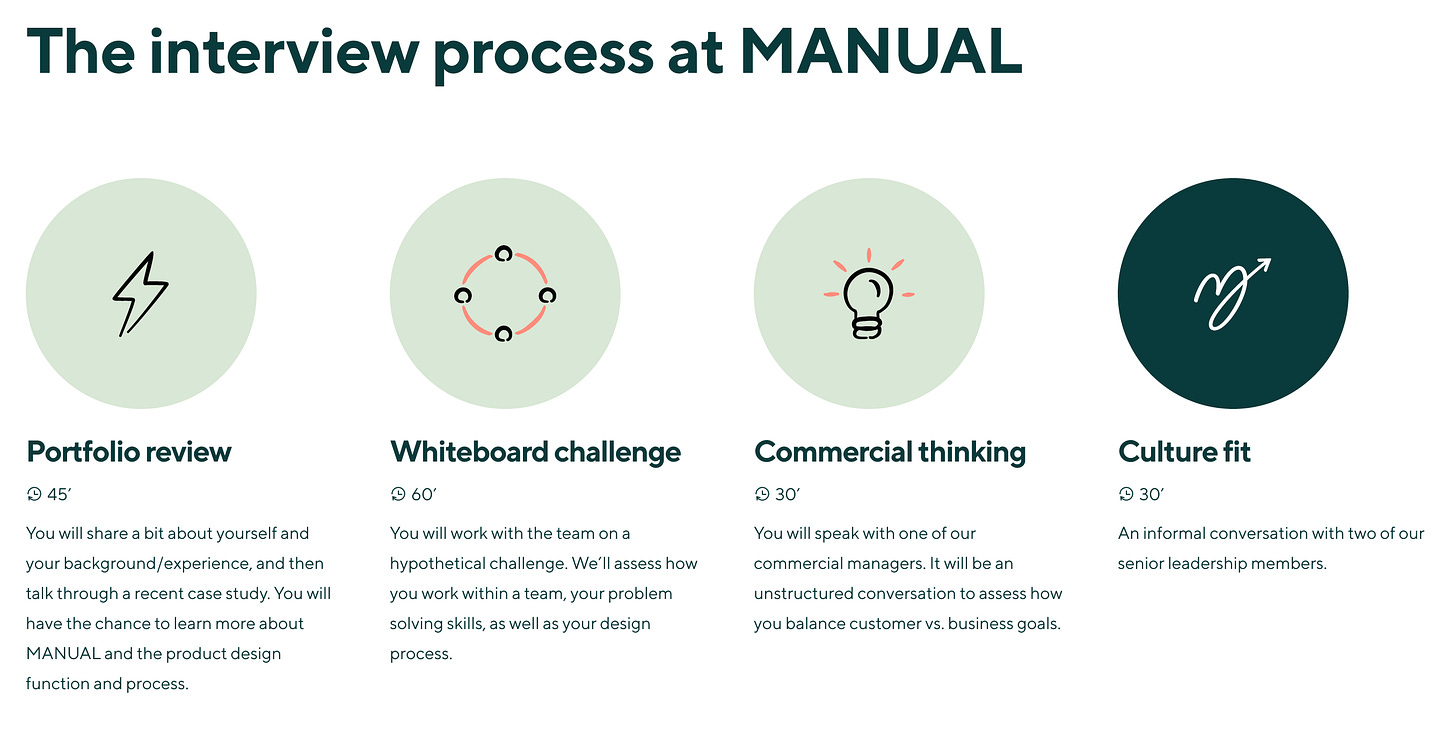I am excited to tell the story behind the design team at MANUAL. Healthcare is an industry where design is needed more than ever and after a recent discussion with Filippos Protogeridis about how he’s building the design team at MANUAL I wanted to record our conversations and share with the community more of behind the scenes.
Filippos is the Head of Product Design at MANUAL. As a hands-on design leader, he has more than 14 years of experience in product design and has been a 4x founding designer for both consumer and business facing startups in the UK and US. Filippos is a big advocate of the strategic role of design in product-led companies.
TL;DR:
Designers operate with the mentality of being in a “startup within a startup”, meaning big ownership and impact on their respective areas of focus.
The interview process at MANUAL is refreshingly quick and straight-foward. (this is rare!)
Strong craft and storytelling skills are a must when they review designers during interview processes.
They measure success on a few different levels; Firstly, what business metrics are being moved by design decisions. Secondly, how much they are delighting or helping patients, and thirdly, how much design is influencing how the company operates and solves its biggest challenges.
MANUAL has been a design-first company since inception, largely due to the fact that the founding team has come from top-tier companies we all recognise.
What is MANUAL’s mission?
We believe that today’s healthcare is broken. (no news there)
It’s overwhelming, it’s confusing. It’s all about fixing problems, but rarely about preventing them. It treats people way too late and in a very siloed way. More importantly, we measure its success by only looking at how long people live, but we don’t care if these years are poorly lived.
To change the paradigm, we look at health as a possibility. Not just measuring how long people live for, but by also looking at people’s quality of life. And we provide people with the guidance to take a few small steps that can change their life completely.
We tackle a number of health conditions that are underserved by the traditional healthcare system such as obesity, hormonal imbalances, hair loss and mental health. For each of these conditions, we have highly specialised medical teams with deep expertise in each respective area.
Along with our medical teams, we create personalised treatment plans for our patients that consist of three things: prescription medication, a lifestyle change framework, and ongoing diagnostics.
Our digital products empower people to safely take their medication, change their lifestyle in a highly personalised way, and get all the support they need on their journey to better health.
What is the design team’s mission and how is it structured?
Everything we do here at MANUAL we are doing because it has a big impact on people’s lives.
We aren’t talking just about features, or brand, or flows. Every single thing deeply impacts how a person:
Understands their health
Starts a treatment journey
Deals with the ups and downs of health
Ultimately changes their lives
This is a big responsibility, and we love working with people that are driven to take on that responsibility.
Product designers at MANUAL are:
Championing the patient’s voice in every conversation.
Entrepreneurial; we see each person as a founding designer of their respective team.
Actively involved in strategy and business decisions.
Very passionate about craft, and creating memorable experiences.
Lastly, we believe that every designer has (or has the potential to have) some sort of superpower. One thing that makes them stand out. And we have no recipe for that, but I always try and find that in every person that joins my team.
Our day to day
Our designers spend their day to day working closely with their respective Product Manager and Technical Lead, but also with commercial leaders, growth marketers, doctors, coaches, people in legal or operations.
We are organised into quads, where we have a “founding designer” model for each health category as well as for each key product e.g. web app or mobile app. We focus on having lean teams with full ownership and responsibility.
The best way to think about working at MANUAL is belonging in a “startup within a start-up”. Even though we are bigger now as an organisation, we still operate with the same mentality we had when we were a 20-person company.
We currently have 7 wonderful product designers and are looking at expanding the team as we continue growing (we are one of the fastest growing healthtech scaleups in the UK!)
Here is a public figma file to meet the team at MANUAL
What is the buy-on for design at MANUAL? Has this changed over time?
We have always been a design-first company from the first months of operating. In an industry like healthcare, we strongly believe that good design is the answer to many of the problems that patients face: overwhelming information, lack of empathy, lack of proper guidance to name a few.
Good design includes everything from brand and creative vision, to product, interface, interaction design, even to how our coaching programme is designed, how our coaches, clinicians and customer support team speaks to our patients. It's at the heart of everything.
Our leadership comes from some of the best design-driven companies in the world (Wise, Deliveroo, Doordash, Slack) and therefore we have been in the lucky position of not ever having to explicitly ask for buy-in.
The more the company evolved, the more we also realised that design was becoming a connecting piece for solving some of our biggest challenges. Some of the biggest problems we have to solve involve doctors, researchers and scientists, commercial managers, legal, marketing and so on. It’s often the designer’s role to connect the dots, align the team and move everyone towards a common goal.
What are the most common mistakes you see designers make when applying for roles at MANUAL?
Not understanding the company at all.
Not reading the brief of our whiteboarding challenge carefully.
Very low energy throughout the process.
No clear superpower: not being able to understand or articulate what the one thing is that makes the candidate stand out.
How can designers prepare for interviews at MANUAL?
We follow a fairly standard interview process and try keep it as short as possible for the candidates to respect their time.
Screening call
Portfolio interview with hiring manager
White-boarding challenge
Leadership sessions
The portfolio interview is key, as it’s the first touchpoint and a true moment for the candidate to shine. I’ll look for personality and cultural fit, a very high demonstrated level of craft, product sense, and an ability to effectively communicate a case study.
I love these first calls, because ultimately it allows me to meet some amazing people in the design world. I’m excited for every single one of them.
I want to leave these calls excited, eager for the next round.
Some tips here:
A large majority of people I speak to, at least 70% show a big lack of energy in these calls. Some sort of excitement to interview with us. And it’s not about someone’s personality; we not expecting everyone to be extroverted. It’s just a clear sign to me that they are simply going through the rounds, and we are just one more company in their big spreadsheet of companies they are applying for.
I want to get excited by the case study. If I’m interviewing a senior+ person, I expect a really high level of communication that takes me through the end-to-end process.
A really hard thing to gauge in these first calls is product sense. When I see perfect case studies I’ll try and understand the candidate’s product thinking a bit more and I’ll ask some interesting/fun questions, like “what would you have done if you had 1/5th of the time” or “what if this completely failed, what’s your next step”. They are questions that are hard to prepare for, and therefore show me someone’s genuine product sense and analytical thinking.
Lastly, I really don’t want to hear about the double diamond or elaborate design frameworks. Show, don’t tell.
Out of 300+ applicants, what makes a designer stand out? What do you really look for?
The first thing I’ll typically look at is someone’s portfolio. I’ll give it a quick glance and look at a few things:
Does it show a solid structure and narrative? Are the case studies easy to follow? If I can’t understand a case study this is an immediate flag.
Does it show a high level of craft?
Am I seeing enough real world end-to-end experience?
If the portfolio checks out, I’ll then start looking for things that make me excited:
Are they someone entrepreneurial? Have they tried founding a business before? Have they built anything?
Have they written any content?
Have they been a founding designer or worked at an early stage startup?
Is there anything interesting about their personality that comes off in the portfolio?
At MANUAL I like to communicate to all candidates that they will be founding desingers in their own respective areas. There is no better way to describe the amount of ownership and impact each designer has on the business.
Because we have a multi-category business and a very lean team, that means that each of our health categories has 1-2 designers max. So the best way to think about it is you are working at a startup within a startup. Whether the category makes it or not is very much up to you, which is why I really want entrepreneurial people that can wear multiple hats and aren’t afraid to go beyond a scope of work.
How do you measure success of the design team?
We measure success on a few different levels. At an organisational level, we look at what business metrics we are moving:
“What initiatives did we drive that had a big business impact?”
This one isn’t just on design. It’s the collective effort of each product squad and, in many cases, a wider working group of key stakeholders that are responsible for moving an important business metric. We see each of these working groups as a startup within a startup, and we want the whole team to be accountable for both their successes as well as the unavoidable failures.
Beyond our business-as-usual, I’ll also look at some more nuanced signals:
How many initiatives were driven by discovery this quarter? (How much did we drive work from our insights?)
What did we launch to take us closer to our product vision? (How much long-term thinking did we do?)
What did we ship that delighted customers? (How much work did we do above our BAU?)
And then lastly I’ll look at some other signals to gauge how successful my team is:
How is my team viewed in the organisation? (I'll measure this through peer reviews and one-to-one chats with stakeholders)
How much is my team driving our strategy? (is my team involved in planning and strategy sessions? Are they influential when in a room with others?)
How much is my team collaborating internally? (is there a healthy amount of mentoring? Is there enough cross-pollination and collaboration?)
We want each designer that's high in seniortiy to be seen as a product leader in the organisation, which is why the aspect of ownership and accountability is so important to me.
What’s in your design team tool stack?
We use Figma for design and prototyping (hint: Figma is not dead!).
We have a fairly robust design system there which allows us to move very quickly at medium to high fidelity. It also allows us to have a common workspace with our brand, creative and marketing teams. All collaborative work happens in Figma, which makes things seamless.
Beyond Figma, a big part of our days is spent whiteboarding. We use Miro for all our whiteboarding needs, workshops, diagraming, brainstorms, design sprints.
In terms of research, we use Userinterviews.com for participant recruitment, and we have our own internal research database to speak to our existing customers. We have recently started using Dovetail to centralise our transcripts and research synthesis as well as to act as our research repository.
Lastly, we use Notion for all our documentation. Notion is our operating centre for product & design, it’s where we record our team principles and strategy, all our team documentation, training material and so on.
Why should someone join the design team at MANUAL? How can they progress?
A designer should join our team if:
They want to have the impact and ownership they would have at an early-stage startup, but at a much larger scale company.
They want to work among some of the smartest people in the industry, across disciplines
They want to solve some of the most interesting problems in healthcare
Progressing at MANUAL is a combination of:
Achieving measurable impact through design
Demonstrating the required level of craft for each seniority milestone
Being an active champion of the customer’s voice
Showing a great sense of ownership
We have a very transparent career progression map and always reinforce continuous evolution for all members of our team. We also try to be as flexible as possible when it comes to management vs. IC pathways, making sure we allow transitions from one to the other.
My takeaways speaking with Filippos about MANUAL’s design team:
It’s rare for a company to put so much emphasis on design at the inception of a company, especially in healthcare. There are a few in the US, but not many, Healthcare processes are often seen as a clunky laborious process.
I love how quick the interview process is. No huge take home tasks, no BS, it’s very clear MANUAL know what they want in designers and know when they spot it.
The approach to viewing designers as “founding designers” is worth noting. I find speaking to designers they often crave the opportunity to have more impact and not working on a tiny part of a product, so MANUAL give opportunities for designers to use design to make business-level impact, not just minor feature tweaking.
If you’re interested in role at MANUAL, please note they are hiring:
Founding App Designer - A Founding Designer to work on a pre-PMF product working in a squad which will be building new products which is a huge growth opportunity for the company.
Growth Designer - The team is looking for someone with strong e-commerce experience to work on the acquisition journey —website and landing pages, medical questionnaire and checkout— and focus on educating and informing customers about healthcare treatments and services.









Interesting to see how designers care to bring more order, structure, and patient-centricity in the healthcare operations.
PS: Many years ago, I spoke to the celebrated content strategist, Scott Abel on the role of product content strategy in healthcare, here is the post: https://medium.com/content-conversations/content-strategy-in-healthcare-an-interview-with-scott-abel-7ae30c97da8f